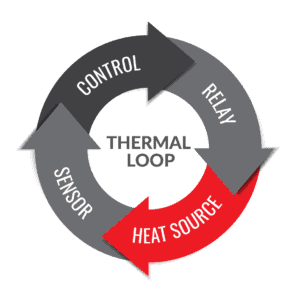Most industrial heating processes utilize a thermal loop to manage specific temperatures. At the core of the thermal loop is the PID controller. This controller is designed to take a temperature sensor input, and then based on that information, signal a relay to apply power to a heating system.

What is the purpose of a thermal loop?
A thermal loop is a description of any system designed to heat or cool: to thermally provide what the system needs. A thermal loop consists of a sensor, controller, relay and a thermal source. So it’s not really a “thing” as much as it just describes a system. People don’t look for a “thermal loop” in the shopping sense.
How does a temperature control loop work?
Based on the above description, a customer has a system that they want to keep at a specific temperature. The sensor can feel this temperature, the sensor is connected to a controller, the controller knows this key temperature, and when the temperature is out of that set point range, it calls for heating or cooling. When it calls for heating or cooling, the TC sends a signal to the relay which allows the source of power to the thermal device, then finally the thermal device turns on. Once the sensor sees that the desired temperature is in range, the temperature sensor provides the feedback to the controller, the controller releases the relay and power is taken away from the thermal source. This can occur anywhere from multiple times per second all the way to 30 seconds.
What is the purpose of a temperature control loop?
Temperature control loops have but one purpose: to maintain a set temperature. Equipment like PID, on off or proportional controllers are used to set temperatures and activate heating mechanisms when the temperature drops beneath a specific threshold.
What is temperature control in a Temperature controller?
Temperature controllers are the brains of the system. Controllers designed to monitor and control temperature come in 3 main types, and those are On/Off, Proportional and PID controllers. Each has their advantages in controlling your process heating system. But what is the difference between a PID, Proportional or On/Off controller?
What are on/off and proportional controllers?
On off and proportional controllers are the most basic and most common types of controllers. A standard thermostat is a great example of these types of temperature controllers. On/off controllers will apply power to the heater right at the set point within a set hysteresis or percentage around the set point, and then will take power off when the temperature is met. Say you have a set point of 100F…and have a 10% hysteresis designed in the controller. At about 90F the process comes on, and then at about 110F it turns off. A large swing in the temperature will occur, and these on/off controllers will have wider swings above and below the desired set points. Proportional controllers will just tighten that up a little more. With that same 100F example, the proportional controller will take that 10% hysteresis and will “straddle” the set point, so the controller will turn the heater on at around 95F, and off at 105F. Much more accurate. On/off is great for large systems or processes not as sensitive to that temperature swing. Proportional temperature controllers are a little better, so good…better. Now let’s talk about best, the PID controller.
What is a PID Controller?
PID controllers are controllers that watch very carefully how heat or cooling is applied to a process. They are much more careful to not under or over shoot a temperature set point. It is the most accurate of all types of thermal loop controllers. PID stands for Proportional, Integral and Derivative.
How does a PID Controller work?
Together, PID functions work together to have a very tightly controlled temp control system. Most PID temperature controllers have a process called “Autotune” that allows a PID controller to “learn” it’s specific system. One using the autotune process would typically energize their system with the controller PID settings set to factory default. In a process heating system for example, with a set point of 150F, a user would initiate the autotune process and see in the heating process a drop of 50 F or so down to around 100F. Then the system would apply heat to get back up to the original set point, from 100 to 150F. It may do this 2-3 times before it learns what P, I, and D settings to apply. The controller actually “learns” your process and applies what it deems are the best settings- and learns how to keep that temperature set point right where it needs to be.
What sensors can be used in a thermal loop?
No matter what method of temperature control you use, both the type and location of your temperature sensor are critical.
Types of sensors, bimetalic switches, mercury filled bulb and capillaries, thermocouples, thermistors or RTDs cover about 99% of all sensor types. Each of these technologies will produce a dependable signal at a given temperature- and their companion temperature controller can translate that signal and compare it to the temperature set point.
Where these sensors are located is critical to the function of any thermal process. If for example you were working to keep a pipe at a specific temperature, that sensor should be right on that pipe…and at the location where that temperature means the most- like at the end or outlet. The same applies for any thermal process, where it is most vital to be at that temperature. Be sure to locate your sensor at that spot.
What is the relay in the thermal loop?
A relay acts just like a valve- when engaged it lets voltage flow to the thermal source. How fast it does that and how carefully it does it is a role that the temperature controller and relay play that is vital to your process. There are three primary methods of relaying power to the heat or cooling source- electromechanical relays, solid state relays and silicone controlled rectifiers.
Electromechanical relays pull in 100% of the power on demand. To follow the analogy above- the valve opens up 100%. Then when the controller determines no more thermal add is required, it is 100% off. These relays work great with on/off and some proportional systems. These relays do have moving parts, and parts that wear out over time. They do also produce a considerable amount of electric “Noise” or RFI, which some systems cannot tolerate.
Solid state relays, or SSR’s can modulate much faster. They can turn on and off in as fast as 1 second. This allows for a much tighter control profile in your thermal process. The trick here is that you have to have a controller that can sense the temperature and call for a change at a very quick rate. Microprocessor based temperature controllers utilizing a PID loop can do the job just fine. These units do not have any moving parts, or components that can wear out. They do produce heat when switching a load, so cooling accommodations must be made.
Finally, silicon controlled rectifiers, or SCR’s provide the highest degree of control of all 3 relay types. SCR’s can turn on and off within one hertz or cycle. Within one second, an electric sine wave crosses from AC to DC 60 times. An SCR can turn on and off right at the at cross, or what is called zero cross, in portions of one second. A PID controller is required to run this type of relay, and an output requesting demand in the form of 0% to 100% of power is also needed. For example, if the temperature of the process needs 20% power applied to keep that set point right on target, then the controller asks the SCR for 20% power, or 12 out of 60 cycles. The SCR can apply power for 12 cycles, and be off for cycles. That’s on for 1/20-th of a second, and off for the rest of the second. Very fine control.
Thermal Loop Equipment from Powerblanket
Thermal control loops are essential for most industrial process heating systems. New technology comes up every year, and It’s important to know what types of equipment will work best for your systems. Powerblanket understands your heating needs and will help you create a heat plan that incorporates thermal loop controls into your organization’s heat plan. Talk to Powerblanket’s engineers today.
Powerblanket's industrial control solutions give you the power to automate, remotely control, and monitor your valuable materials and equipment.


